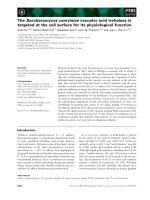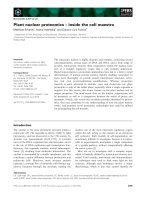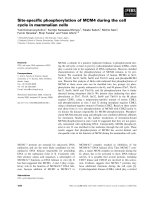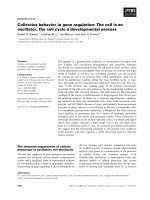43922 explore the cell
Bạn đang xem bản rút gọn của tài liệu. Xem và tải ngay bản đầy đủ của tài liệu tại đây (180.43 KB, 1 trang )
Science Explore Activity: Plant and Animal Cells
What is the Basic Unit of Life?
All living things are made up of Cells. Cells are the
smallest thing capable of life. Most cells are very small, so small,
in fact, that they cannot be seen with the naked eye; but there are
some single cells that are so large that you can hold them in your
hand. The largest single cell in the world is the Ostrich egg.
There are two types of cells in the world: Plant and Animal.
Both types have many similarities in how they maintain life but
each has something different that allows them to do special
things.
The first type of cell is an animal cell. Animal cells are
made up of a Nucleus, other Organelles, and a Membrane.
Animal cells can bend and change their shape. Animal cells get
their energy and vitamins by eating other things.
The second type of cell is the plant cell. Plant cells have
all the same parts as animal cells but they have a two pieces that
animal cells do not have: A cell wall and chloroplasts.
Chloroplasts turn sunlight into energy for the cell, that way the cell
does not have to try to find something else to eat. Cell walls are a
hard cover that surrounds a plan cell outside of the cell
membrane. The cell wall gives the cell a definite shape.
Cell: The most basic form
of life.
Nucleus: The control center
of a cell.
Organelle: parts of cells that
do special jobs.
Membrane: flexible cover
that holds a cell together
Cell Wall: A hard, rigid,
cover that surrounds plant
cells
Chloroplast: A special
organelle that houses
chlorophyll, something that
turns sunlight into energy.









